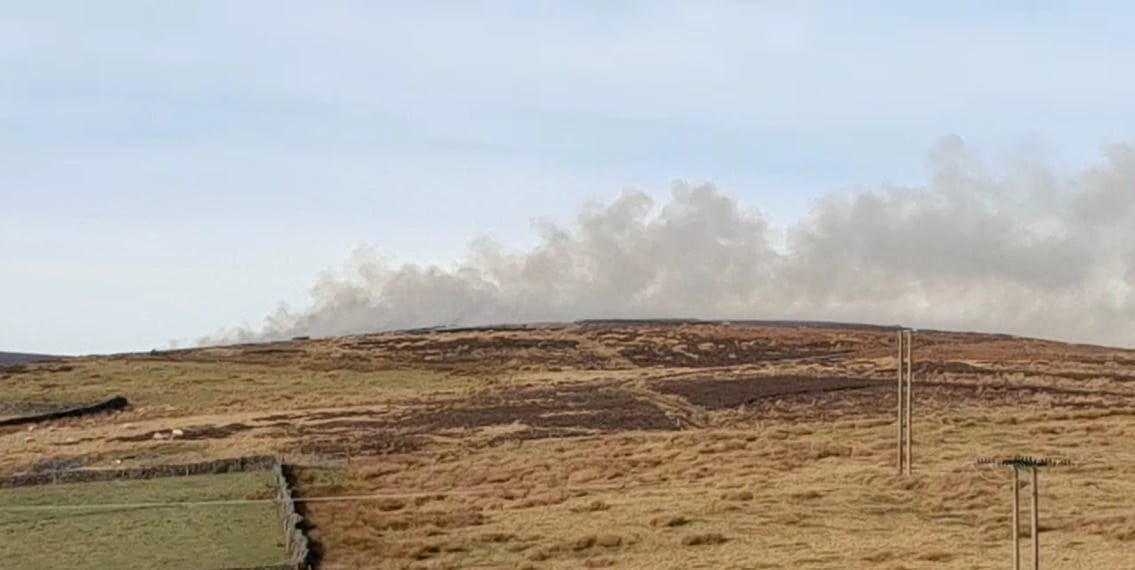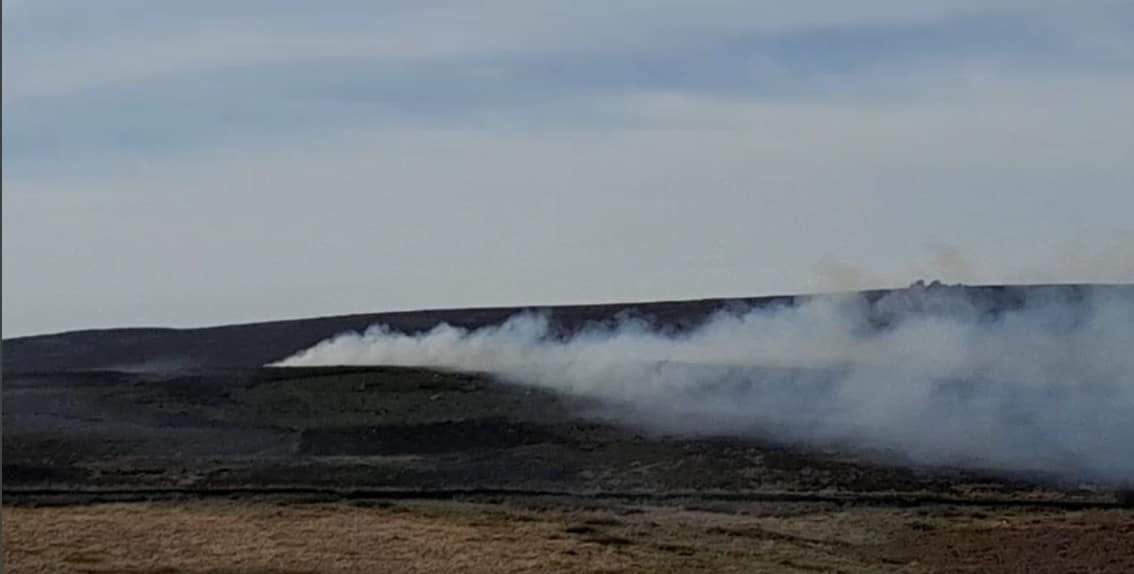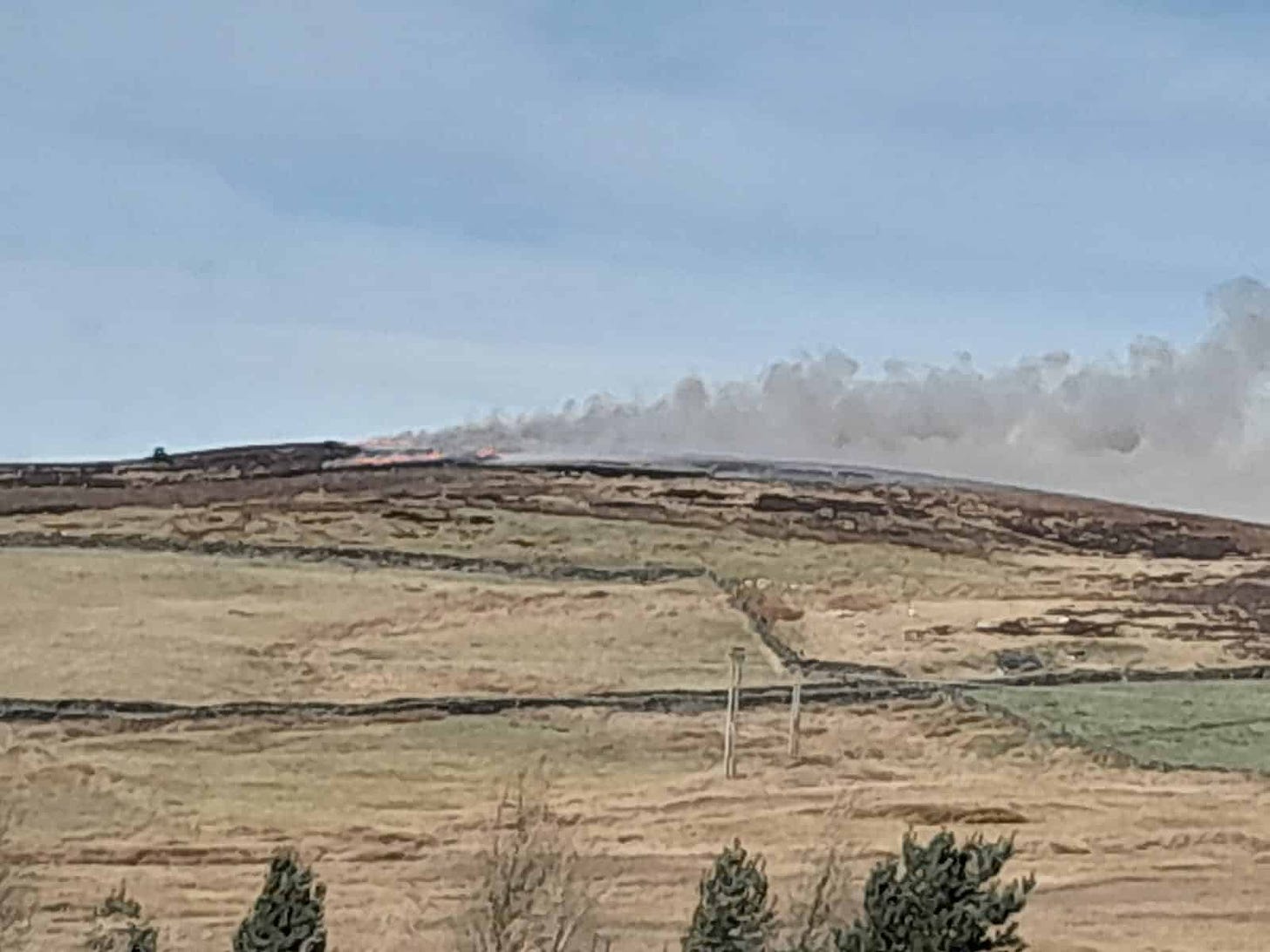Gamekeepers burn moors above Sheffield
Avian Flu, declining biodiversity, and growing awareness of animal sentience, be damned. Warnings about the impacts of air pollution and microscopic smoke particulates on lung health and chronic respiratory problems, be damned. Climate change, be damned. Opportunities for local residents to enjoy the first blue skies and the first fresh air of the coming spring, be damned.
Not a message most of us would want to be giving out, but moor owners already preparing for the Inglorious 12th and the autumn slaughter of Red Grouse have never given much thought to wildlife or the public at large when setting fire to moorlands. All they're interested in is raising what they casually call a 'surplus' of grouse for the gun.
It's the gamekeeper's job (when not killing as many native predators and the occasional Hen Harrier as possible) to provide Red Grouse with a mosaic of heather. Adult birds need older, thicker clumps to nest in, while younger birds feed on the buds of younger, growing heather. The simplest way to do that is to mark off rectangles of moorland and burn it to the ground.
And, to invert the well-known phrase, where there's fire there is smoke. A lot of it...


These images were given to us to post by a pro-wildlife activist who spends much of their time out on the moors, checking for snares, illegal traps, and raptor persecution. They were taken on the 8th February this year, and actually come towards the end of what is described as the 'burning season' which runs between October 1st and April 15th.
This means that these are scenes that will have already been repeated over and over again on moorlands across England and Scotland - often within our so-called 'national parks', large areas of which are privately owned by shooting estates.
'Slash and burn'
There has been mounting calls for the 'slash and burn' practice to stop for more than a decade. Blanket bogs (extensive flat peat bogs) on upland moors are not only biologically-rich landscapes - many of these areas contain Sites of Special Scientific Interest (SSSi) - but they can hold enormous stores of carbon. In England, it is estimated that each year damaged upland peat bogs release the same amount of CO2 into the atmosphere as 140,000 cars and in Scotland, peatlands are responsible for 13% of all emissions.
Recent history would indicate that the government is not 'minded' to do very much about it though.
Rather than bring in an enforceable ban, a voluntary agreement with grouse moor owners to stop burning on peat-rich areas of moorland was suggested in 2018 by Michael Gove, then Environment Secretary. Instead of the enforceable ban that was required, he was accused of offering a voluntary ban as a way of persuading landowners that if they didn't change their ways a ban was inevitable. Inevitably, they ignored him.
In October 2018 Guy Shrubsole, of the campaign group Who Owns England, published a detailed examination of which moor owners were planning to stop burning on the back of Gove's pandering. He discovered that hugely influential and powerful estates were planning to carry on as normal, including Walshaw Moor above Hebden Bridge (the same estate whose intensive burning led to the RSPB lodging a complaint with the European Court of Justice in 2012), Envile & Stalybridge Estate (where a huge fire on Saddleworth Moor that summer had hit the headlines), and Mossdale Estate owned by the Van Cutsem family, close friends of the Royals and notorious for both a pole-trap incident on the estate in 2016 and for William Van Cutsem being with Prince Harry when two Hen Harriers were killed in Norfolk in 2007.
Bogs need water not fire
In 2020 the normally risk-averse RSPB called for "a ban on burning blanket bog in England to prevent ongoing losses of carbon, increase their resilience to climate change and restore their rare wildlife to good health", saying that 'Bogs need water not fire". They also said that "information from Natural England suggests there were over 400 consents to burn blanket bog on grouse moors in north England’s European protected areas, covering around 950 square kilometres of the (deep) peat soils this precious habitat depends on."
In 2021 the government - at last - introduced a new law partially banning the burning of our peat moors. But as so often with any legislation that attempts to curtail the hobbies of the influential and wealthy, it had many loopholes. Landowners could still burn moorland if the peat was shallow (less than 40cm), if the moor wasn’t within a conservation zone such as an SSSI, or was too steep or rocky to mow. And as usual, the government were on hand to provide a licence to any landowner who found the new restrictions a little too bothersome.
So how did the 'ban' go? Predictably, is the answer. Wild Moors (the upland restoration organisation, working to protect and strengthen wildlife, habitats and communities) stated that, "There were over 1,200 reported burns across northern England during the 2021 – 2022 season." That was just Northern England, remember. In June 2022, in a moving article, Protect the Wild's Eliza Egret reported that an Unearthed investigation had revealed that between 1 October 2021 and 15 April 2022, England’s peatland was set on fire 251 times. The RSPB reported that of 125 burns reported to them between October 2021 and January 2022, 75% were on protected sites.
Nothing changes - we must change that!
So here we are, in late winter/early spring 2023, shooting estates are still obsessed with putting as many Red Grouse in front of as many guns as possible, fires are burning, and smoke is filling the air.
Nothing changes, and as for wildlife and the rest of us? As stated at the top of this post, we can be damned...
As well as burning protected sites, the shooting industry kills as many 500,000 Red Grouse every year. Protect the Wild is working to End Shooting in the UK
The Moorland Monitors, a grassroots community network working to protect persecuted wild species and wild spaces on driven grouse shooting estates, is online at moorlandmonitors.org/
We can report a burn via the RSPB website and searching for Upland Burning or by downloading the My Survey123 app (available on iOS and Android).




